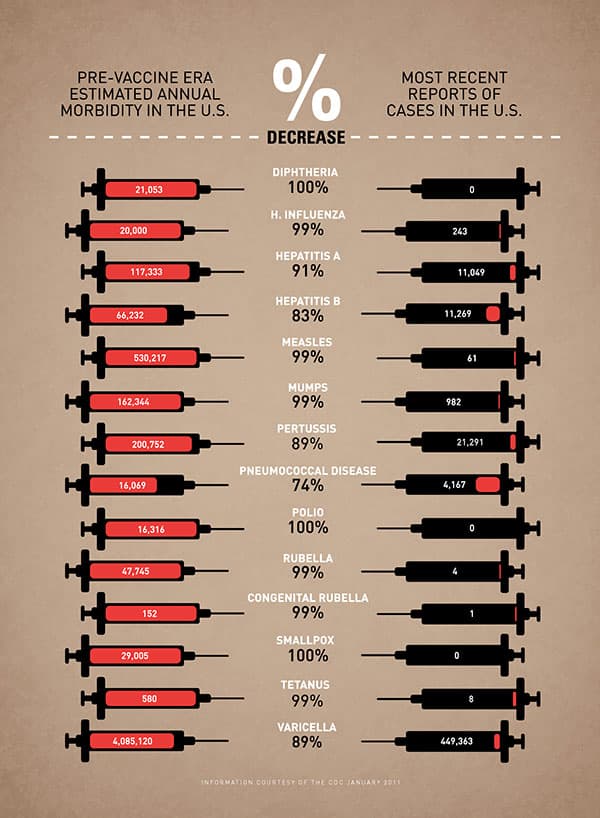Benefits of Vaccines
How Vaccines Work
While a lot of medical practice is focused on treating the sick, vaccination is a rare opportunity to prevent infection and the course of a disease from ever happening. In fact, an entire disease agent can be driven into eradication through vaccination, as was the case for variola virus that causes smallpox disease. In the 20th century alone, smallpox killed some 300 million people before it was halted by vaccination.21
There are increasing concerns of bacterial agents rapidly evolving under selective pressures from antibiotics. It is a well-known fact that antibiotics are becoming less and less effective. Vaccination is an obvious answer. Vaccination primes the body’s immune system to fight off disease causing agents without the use of antibiotics and can entirely prevent the course of illness. Developing vaccines is no easy task. Because creating vaccines is difficult, antibiotics are still very important for treating disease.
There are two basic categories that vaccines fall into: active and passive. Active vaccines can include live and non-live vaccines, because it produces a strong immune response, making it a better vaccine.22 Essentially, the adaptive immune system develops a “memory” of foreign invaders and will be primed to protect the body once exposed.
The human immune system has the ability to respond to foreign invaders in specific ways and non-specific ways. It can take days for the immune system to craft a specific response to an invading microorganism, and those days can be critical in terms of surviving the infection. During that intervening period the virus or bacterium could be exponentially reproducing. This can lead to the onset of severe diseases, and the victim also can be contagious and spread the infection to others. Vaccination closes the window to create a specialized response, priming the body to immediately fight off the invader, helping to prevent or shorten an illness and stop the spread of the disease causing agent.
Herd Immunity
Herd immunity, sometimes also called community immunity, occurs when the number of people vaccinated and fully immunized is high enough as a proportion of the population to prevent the spread of a disease causing pathogen even to those who are unvaccinated and vulnerable.23
Japan offers a case study that demonstrates the importance of keeping vaccination rates high enough to confer herd immunity. Between the years 1962 and 1987, school-aged children were required to be vaccinated against influenza virus that causes the flu, not just to protect the children being vaccinated, but also to protect the elderly, nonvaccinated citizens of Japan. There is a significant portion of the elderly population in Japan that lives with extended family, including school aged children. Incidence of flu, including death rates, fell during this period. The program of mandatory vaccination was discontinued in 1994. The authors of the study believe that 37,000 to 40,000 deaths were prevented annually by the program. Additionally, they found while the program was in effect, one death was prevented for every 420 children vaccinated.24

Figure 3: Pre-Vaccine era estimated annual morbidity (death) in the U.S. as compared to the most recent reports as of 2011. Creative Commons 4.0. Author: Leon Farrant.
According to the World Health Organization, 3 million lives are saved annually thanks to vaccination, and 750,000 children are saved from disability.25 Other organizations, like UNICEF credit immunization for saving 9 million lives each year.26
Vaccination is key in saving lives. Vaccines make once fatal infections less of a threat by preparing our immune systems to fight them. This has drastically cut down on the disease mortality of many infectious agents, including those causing the diseases diphtheria, hepatitis, polio, smallpox and many others. In doing a simple cost benefit analysis to decide if vaccinations are worth the trouble, how should we value a human life? Or 3 million human lives? Any rational thinker or voter with real research and data before them would have to say that vaccines have done an amazing job at making the world safer for human existence. UNICEF projects that if vaccines were used against all vaccine preventable diseases, an additional 16 million lives could be saved each year.
Disease Eradication
Famously, smallpox was declared eradicated in 1980. Smallpox was the first vaccine available and the breakthrough of smallpox eradication came after decades of constant work to diligently vaccinate people around the entire planet. So far, smallpox is the only human disease that has been completely eradicated, but that does not mean that it will be the last. Additionally, Rinderpest, a bacterial disease that affected cattle, has also been globally eradicated.
According the Centers for Disease Control, the numbers are straightforward, and progress is being made. In the United States, measles was a common if not universal childhood disease. Most doctors in the modern era have not seen a case of the measles. In 1921, 15,000 Americans died because of the measles. Only two cases were reported between 2004 and 2014. Between 1964-65, 12.5 million Americans were killed by the viral disease rubella during an epidemic. 2,000 babies were killed, and 11,000 miscarriages took place. Since 2012 there have been 15 cases reported to the CDC.27
By aiming to attain high enough levels of vaccination coupled with the effects of herd immunity, diseases like polio could easily be next on the list for complete global eradication. Already polio has gone from a worldwide-threat that was potentially fatal or could cause lifelong disability, to being reduced by 99%; In fact, there are just three countries where polio has not been completely eradicated.28
This does not mean that vaccination is perfect, nor does it mean that vaccination comes without costs.

Comments: